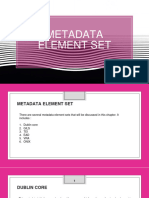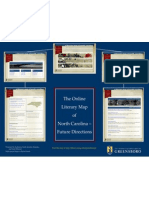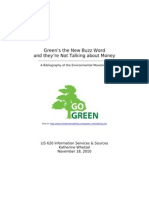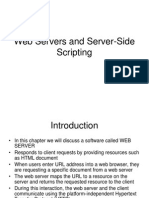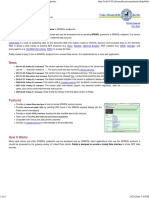I. Identify Desired Metadata Elements For The Collection: Developing A Metadata Element Set
I. Identify Desired Metadata Elements For The Collection: Developing A Metadata Element Set
Uploaded by
api-133844763Copyright:
Available Formats
I. Identify Desired Metadata Elements For The Collection: Developing A Metadata Element Set
I. Identify Desired Metadata Elements For The Collection: Developing A Metadata Element Set
Uploaded by
api-133844763Original Title
Copyright
Available Formats
Share this document
Did you find this document useful?
Is this content inappropriate?
Copyright:
Available Formats
I. Identify Desired Metadata Elements For The Collection: Developing A Metadata Element Set
I. Identify Desired Metadata Elements For The Collection: Developing A Metadata Element Set
Uploaded by
api-133844763Copyright:
Available Formats
LIS 688 -Assignment 2 Laura Soito, Caroline McDonald, Maggie Willis
Developing a Metadata Element Set I. Identify desired metadata elements for the collection
Desired Element Explanation and Description of the Element (This will be the element definition and will be included in the final schema.) The Title element records the titles, identifying phrases, or names given to a work. The identity of any one individual or corporate body that played a role in the creation of a work. Example (The examples may be included in a best practice guide, either within the schema or in a separate guide) Implementation (Mandatory Optional Repeatable) M, R Comments (why we chose these elements) title is a main point of identification for a work of art creator is another main point of identification, usually works are located using title or creator as search terms Date can provide a temporal context for a work. Since we have publication dates for the cartoons, we chose to qualify the date element to date created to better describe the resource. Publication date may vary from creation date, so an additional element was added.
1. Title Text
Adoration of the Magi Ceramic Bowl Magee, John L. Feature Animation, Disney Studios, Walt Disney Company YYYY-MM-DD YYYY-MM YYYY
2. Creator Identity
M, R
3. Date Created
The date of creation of the work.
4. Date Published
The date of publication of the work
YYYY-MM-DD YYYY-MM YYYY
O, R
LIS 688 -Assignment 2 Laura Soito, Caroline McDonald, Maggie Willis
5. Cultural Context The name of the culture from which the work originates or is associated with. American O, R Cultural context aids in the association of works that may have similar cultural or geographic themes. Subject allows works with on a similar topic to be associated and helps to identify works when a user knows what the work features, but does not know the works title format is essential when cataloging a work of art due to variety as well as the identification of works with their physical format it is helpful to know what a work will look like in terms of physical size as well as file size a common way of interpreting a work of art is based on how it is made, using what materials
6. Subject
The topic of the content of the resource
Monkeys Presidential elections-United States
O, R
7. Work Type
Identifies the kind of work or works being described. Work Type typically refers to a work's physical form, function, or medium.
political cartoon painting
M, R
8. Dimensions Description
Information about the dimensions, size, or scale of the work, presented in syntax suitable for display to the end-user.
17488 kb (jpeg) 2100 x 1557 pixels 92 x 72 cm (36 1/2 x 28 3/ 8 inches) oil on canvas print on wove paper
M, R
9. Materials/Techniques Description
An indication of the substances or materials used in the creation of a work, as well as any implements, production or manufacturing techniques, processes, or methods incorporated in its fabrication.
M,R
LIS 688 -Assignment 2 Laura Soito, Caroline McDonald, Maggie Willis
10. Inscription Caption All written words in the work, including captions and signatures. O, R 11. Language Language used in work or caption. Caption, bottom, What a beautiful day. Signed, lower right, "Henri Matisse 08" English French The cartoon depicts a man riding an elephant through a jungle. This work was produced after the artist traveled to India. O, R While not all cartoons contain text, the caption element can aid in finding cartoons containing text Language could aid in automated translation of text. this element allows for any additional information that applies to interpreting and understanding the resource, especially helpful since the cartoons are primarily images this element aids in identifying a place that users might be able to observe an original copy or gain more information about the resource this element allows us to identify the original source of the item this element displays the current digital location of the resource as well as providing a unique tag
12. Descriptive Note Text
A narrative text or prose description and discussion of the work or group of works.
13. Location Repository
The geographic location and/or name of the repository, building, site, or other entity whose boundaries include the work.
Library of Congress
14. Source
Citation for publication where the work has been published. An unambiguous reference to the work within a given context.
New York Times, Jan. 15, 1908, p28
O, R
15. Identifier
http://www.loc.gov/
pictures/collection/app/ item/2002708981/
LIS 688 -Assignment 2 Laura Soito, Caroline McDonald, Maggie Willis
16. Rights Information about rights for the work.
Access limited to members
M, R
this element provides information about the rights related to the resource
LIS 688 -Assignment 2 Laura Soito, Caroline McDonald, Maggie Willis
Developing a Metadata Element Set II. Decision for value spaces: content and value specifications, vocabularies
Element Name (The element defined by the last task) 1. Title Text 2. Creator Identity Value controlled? (Yes or No, and How) Value controlled? (Yes or No, and How)
No Yes, rule
free-text field Last, First M. ex: Magee, John L. Use YYYY-MM-DD, YYYY-MM, or YYYY as known. If unknown, provide best guess.
3. Date Created
Yes, rule
4. Date Published
Yes, rule
Use YYYY-MM-DD, YYYY-MM, or YYYY as known. Use nationality or another cultural identity associated with the artist or the work itself. Terms are available in the Getty Union List of Artist Names nationality list. Use Library of Congress Subject Headings. Use Art & Architecture Thesaurus. Use the recommendations provided by CDWA: Include measurements in both metric units and US Customary Units (inches, feet), if possible. Record dimensions height by width by depth (if appropriate) (e.g., 198 x 233 x 82 cm (78 x 91
5. Cultural Context
Yes, thesaurus
6. Subject 7. Work Type 8. Dimensions Description
Yes, controlled vocabulary Yes, controlled vocabulary Yes, rule
LIS 688 -Assignment 2 Laura Soito, Caroline McDonald, Maggie Willis
3/4 x 32 1/4 inches)). The orientation is thus implied in the description of the dimensions: for example, dimensions of a painting of vertical orientation is implied in 92 x 72 cm (36 1/2 x 28 3/8 inches). Use standard codes for metric units (e.g., cm for centimeters). Spell out inches and feet. 9. Materials/Techniques Description 10. Inscription Caption 11. Language Yes, controlled vocabulary Yes, rule Yes, list Use Art & Architecture Thesaurus Type of text, location of text, quote of text Use the 3 character language codes associated with ISO 639-2. Free text The Getty Thesaurus of Geographic Names Periodical Publication, date, page Editor/Author, Publication, date, page Uniform Resource Identifier (URI) Free text or URL
12. Descriptive Note Text 13. Location Repository 14. Source 15. Identifier 16. Rights
No Yes Yes, rule No No
LIS 688 -Assignment 2 Laura Soito, Caroline McDonald, Maggie Willis
Developing a Metadata Element Set III. Establish an Application Profile (The namespace for our element set is uncg)
Element Name (The element defined by the last task) Matched CDWA Element and Qualifier Matched VRA Element and Qualifier Matched DC Element and Qualifier Additional uncg qualifiers for matched SCHEMA elements
1. Title Text 2. Creator Identity 3. Date Created 4. Date Published 5. Cultural Context 6. Subject 7. Work Type 8. Dimensions Description 9. Materials/Techniques Description 10. Inscription Caption 11. Language 12. Descriptive Note Text
cdwa.titleText cdwa.creatorIdentity dc.date.created dc.date.issued vra.culturalContext dc.subject cdwa.workType cdwa.dimensionsDescription cdwa.materialsTechniques. description vra.inscription.caption dc.language cdwa.descriptiveNote.text
LIS 688 -Assignment 2 Laura Soito, Caroline McDonald, Maggie Willis
13. Location Repository 14. Source 15. Identifier 16. Rights vra.location.repository dc.source dc.identifier dc.rights
LIS 688 -Assignment 2 Laura Soito, Caroline McDonald, Maggie Willis
Developing a Metadata Element Set IV. Create Crosswalks
UNCG Element (as a source schema) 1. Title Text 2. Creator Identity 3. Date Created 4. Date Published 5. Cultural Context 6. Subject 7. Work Type 8. Dimensions Description 9. Materials/Techniques Description 10. Inscription Caption 11. Language 12. Descriptive Note Text 13. Location Repository 14. Source 15. Identifier Title Creator Date Date Coverage Subject Type Format Format Description Language Description Source Source Identifier Dublin Core Element MODS 3.4 Element
<titleInfo><title> <name> <originInfo><dateCreated> <originInfo><dateIssued> <subject><geographic> <subject><topic> <genre> <physicalDescription><form> <physicalDescription><form> <note> <language> <note> <location> <physicalLocation> <originInfo> <identifier>
LIS 688 -Assignment 2 Laura Soito, Caroline McDonald, Maggie Willis
16. Rights Rights <accessCondition>
LIS 688 -Assignment 2 Laura Soito, Caroline McDonald, Maggie Willis
Developing a Metadata Element Set V. Write a Specification for the complete element set
Element name: Title Description: The Title element records the titles, identifying phrases, or names given to the cartoon. Data Values: Free-text. This is not a controlled field. Best practice: Record titles and names in title case, not sentence case. Maintain consistent capitalization, punctuation, and syntax in titles across the database where possible. Capitalize proper names in the title. For titles derived from authoritative sources, follow the capitalization and punctuation of the source. Mapping to schemes -- DC: Title and MODS: <titleInfo><title> Required: M Repeatable: Y (One title for each work must be flagged as preferred.) Element name: Creator Description: The identity of any one individual or corporate body that played a role in the creation of the cartoon. Data Values: Best practice is to use ULAN. Mapping to schemes -- DC: Creator and MODS: <name> Required: M Repeatable: Y Element name: Date Created Description: A point of time associated with the creation of the work. Data Values: Recommended best practice is to use date consistent with W3CDTF profile of ISO 8601. If the Creation date is unknown provide best guess.. Mapping to schemes -- DC: Date and MODS: <originInfo><date> Required: M Repeatable: N Element name: Date Published Description: A point of time associated with the publication of the work. Data Values: Recommended best practice is to use date consistent with W3CDTF profile of ISO 8601. Mapping to schemes -- DC: Date and MODS: <originInfo><dateIssued> Required: M Repeatable: N Element name: Cultural Context Description: The name of the culture from which the cartoon originates or is associated with. Data Values: Use nationality or another cultural identity associated with the artist or the work itself. Use terms that are available in the Getty Union List of Artist Names nationality list. Mapping to schemes -- DC:Subject and MODS:<subject><geographic>
LIS 688 -Assignment 2 Laura Soito, Caroline McDonald, Maggie Willis
Required: O Repeatable: Y Element name: Subject Description: The topic(s) of the content of the cartoon. Data Values: Use Library of Congress Subject Headings. Mapping to schemes --MODS:<subject><topic> Required: O Repeatable: Y Element name: Type Description: The Work Type element identifies the kind of work or works being described. Work Type refers to the cartoons physical form, function, or medium. Data Values: Use controlled vocabulary A&AT. Mapping to schemes -- DC: Type and MODS:<genre> Required: M Repeatable: Y Element name: Dimensions Data values: Best practice is to use specifications from CDWA: Include measurements in both metric units and US Customary Units (inches, feet), if possible. Record dimensions height by width by depth (if appropriate) (e.g., 198 x 233 x 82 cm (78 x 91 3/4 x 32 1/4 inches)). The orientation is thus implied in the description of the dimensions: for example, dimensions of a cartoon print of vertical orientation is implied in 92 x 72 cm (36 1/2 x 28 3/8 inches). Use standard codes for metric units (e.g., cm for centimeters). Spell out inches and feet. Mapping to schemes -- DC:Format and MODS:<physicalDescription><form> Required: M Repeatable: Y Element name: Materials/Techniques Description: An indication of the substances or materials used in the creation of a work, as well as any implements, production or manufacturing techniques (ex. lithograph, pen and wash drawings), processes, or methods incorporated in its fabrication. Data values: A&AT Mapping to schemes -- DC: Format and MODS:<physicalDescription><form> Required: M Repeatable: Y Element name: Caption Description: All marks or written words added to the object at the time of production or in its subsequent history, including signatures, dates, dedications, and texts as well as marks, such as the publishers or printers. Data Values: This is not a controlled field. Information is taken directly from the object.
LIS 688 -Assignment 2 Laura Soito, Caroline McDonald, Maggie Willis
Mapping to schemes -- DC:Description and MODS:<note> Required: O Repeatable: Y Element name: Language Description: Language used in the cartoon or cartoon caption. Data Values: Use the 3 character language codes associated with ISO 639-2. Mapping to schemes --MODS:<language> Required: O Repeatable: Y Element name: Descriptive Note Description: A narrative text or prose description and discussion of the work or group of works. Data Values: Free Text. Use natural word order. You may use phrases or complete sentences, but always begin the note with capital letter and end it with a period. Use sentence case (not all capitals or title case). Capitalize proper names. Avoid abbreviations. Write the note in the language of the catalog record (English in the United States). Names and other words in foreign languages may be used within the note when there is no commonly used English equivalent. Use diacritics as appropriate. Mapping to schemes -- DC:Description and MODS:<note> Required: O Repeatable: N Element name: Repository Location Description: The geographic location and/or name of the repository, building, site, or other entity whose boundaries include the Work or Image. Data Values: The Getty Thesaurus of Geographic Names Mapping to schemes -- DC: Source and MODS: <location><physicalLocation> Required: O Repeatable: N Element name: Source Description: A related resource from which the described resource is derived. Citation for publication where the cartoon has been published. Data Values: Provide publication information as follows: Periodical Publication, date, page or Editor/Author, Publication, date, page Mapping to schemes -- MODS:<originInfo> Required: O Repeatable: Y Element name: Identifier Label: Identifier Description: An unambiguous reference to the resource within a given context.
LIS 688 -Assignment 2 Laura Soito, Caroline McDonald, Maggie Willis
Data Values: Free Text. Uniform Resource Identifier (URI). Recommended best practice is to identify the related resource by means of a string conforming to a formal identification system. Mapping to schemes --MODS:<identifier> Required: M Repeatable: N Element name: Rights Description: Information about rights held in and over the resource. Data Values: Free Text or URL. Typically, rights information includes a statement about various property rights associated with the resource, including intellectual property rights. Mapping to schemes --MODS:<accessCondition> Required: M Repeatable: Y
You might also like
- Module 5 Metadata Schema Assignment TemplateDocument6 pagesModule 5 Metadata Schema Assignment Templateapi-547265305No ratings yet
- Computer Technology - Library Automation & DigitizationDocument138 pagesComputer Technology - Library Automation & Digitizationpooja komari100% (5)
- Accessibility in Academic Libraries For Users With DisabilitiesDocument6 pagesAccessibility in Academic Libraries For Users With Disabilitiesapi-133844763No ratings yet
- ProVision Plus 2 - 4 - 0 NBI System Integration Guide - May2019Document66 pagesProVision Plus 2 - 4 - 0 NBI System Integration Guide - May2019nea317No ratings yet
- Semantic Data GuideDocument11 pagesSemantic Data GuidetukashabayonahNo ratings yet
- Design and Implementation of The QBOE Query Language For Multimedia Database SystemsDocument30 pagesDesign and Implementation of The QBOE Query Language For Multimedia Database SystemsAnugrahJonanNo ratings yet
- Assignment: Student NameDocument4 pagesAssignment: Student NameMàhàvěęř ŔámèśhNo ratings yet
- Documento 4 de GonzaloDocument26 pagesDocumento 4 de Gonzaloyarlei.luna117No ratings yet
- An Introduction To Topic Maps: Journal 5Document14 pagesAn Introduction To Topic Maps: Journal 5Ozioma IhekwoabaNo ratings yet
- Database Processing:: Online Appendix GDocument46 pagesDatabase Processing:: Online Appendix GCarlos Alberto LeònNo ratings yet
- TopicMaps Iso13250 2nd Edition Version2Document50 pagesTopicMaps Iso13250 2nd Edition Version2r1pp3r1183No ratings yet
- Ch2-Elementary Concept of Data and TimeDocument9 pagesCh2-Elementary Concept of Data and TimelavanyaNo ratings yet
- Classes and ObjectsDocument30 pagesClasses and ObjectsAltan GuialodenNo ratings yet
- Modern Database Techniques Part 1: Object Oriented DatabasesDocument168 pagesModern Database Techniques Part 1: Object Oriented Databasespakku009No ratings yet
- Mailam Engineering College: Mailam (Po), Villupuram (DT) - Pin: 604 304 Department of Computer ApplicationsDocument11 pagesMailam Engineering College: Mailam (Po), Villupuram (DT) - Pin: 604 304 Department of Computer ApplicationsSubathra Devi MourouganeNo ratings yet
- Tomasic Simon DELOS1996Document5 pagesTomasic Simon DELOS1996postscriptNo ratings yet
- Assignment: Student NameDocument4 pagesAssignment: Student NameShrey TyagiNo ratings yet
- Representing Gridded and Space-Time Data in Hydroshare: Oci-1148453 Oci-1148090Document1 pageRepresenting Gridded and Space-Time Data in Hydroshare: Oci-1148453 Oci-1148090Consortium of Universities for the Advancement of Hydrologic Science, Inc.No ratings yet
- DSA Course OutlineDocument4 pagesDSA Course Outlineseyramcollins54No ratings yet
- Assignment No-4Document2 pagesAssignment No-4Aditya GuptaNo ratings yet
- Datasets in machine learning Unit 2Document15 pagesDatasets in machine learning Unit 2riteshpc13No ratings yet
- Rasmussen Blank07ddiDocument18 pagesRasmussen Blank07ddiazzelerlmNo ratings yet
- Powe PoinDocument3 pagesPowe PoinwatungwaetinaNo ratings yet
- Oomd QB AnswerDocument62 pagesOomd QB AnswerAlok KamalkarNo ratings yet
- DWDM - Unit - VIIIDocument32 pagesDWDM - Unit - VIIISaidulu InamanamelluriNo ratings yet
- Activity 2. SequencingDocument5 pagesActivity 2. SequencingCarlito T. GelitoNo ratings yet
- Capstone Project Proposal TemplateDocument5 pagesCapstone Project Proposal TemplateJano FernandezNo ratings yet
- Tag RecommendationsDocument17 pagesTag RecommendationsCatalin CristianNo ratings yet
- CSE-22121 Assignment Summer-24Document2 pagesCSE-22121 Assignment Summer-24kamruzamanshuvo24No ratings yet
- M1086 Chapter 3Document43 pagesM1086 Chapter 3sreem naga venkata shanmukh saiNo ratings yet
- Module 5 Metadata Schema Assignment TemplateDocument12 pagesModule 5 Metadata Schema Assignment TemplateHMNo ratings yet
- Week 3Document16 pagesWeek 3laarniNo ratings yet
- PDF Article Metadata Harvester: Jurnal Komputer Dan InformatikaDocument6 pagesPDF Article Metadata Harvester: Jurnal Komputer Dan InformatikaDedeMuhammadLuthfiNo ratings yet
- Report DaamDocument6 pagesReport Daamapi-653075991No ratings yet
- Narrative Science Systems: A ReviewDocument6 pagesNarrative Science Systems: A ReviewWhite Globe Publications (IJORCS)No ratings yet
- Katakis Ecmlpkdd08 ChallengeDocument9 pagesKatakis Ecmlpkdd08 ChallengeID CloneNo ratings yet
- 5th Grade Musculoskeletal SystemDocument6 pages5th Grade Musculoskeletal SystemkrisnuNo ratings yet
- 1 BIT 2214 OOAD Summarised NotesDocument22 pages1 BIT 2214 OOAD Summarised NotesRorlundKennedyNo ratings yet
- Part2 - Ch3 - Data Modeling Using The Entity Relationship ModelDocument34 pagesPart2 - Ch3 - Data Modeling Using The Entity Relationship Modela8831952No ratings yet
- Data MiningDocument13 pagesData MiningSaksham Kumar MauryaNo ratings yet
- OO ConceptsDocument69 pagesOO ConceptsDivyansh GuptaNo ratings yet
- 4-Chapter 11 - 15Document8 pages4-Chapter 11 - 15mostafabomalekNo ratings yet
- Chapter 6 Metadata Elements SetDocument62 pagesChapter 6 Metadata Elements Setlost soulNo ratings yet
- Lecture-1 - CSE-225 Tamanna Motahar NSUDocument38 pagesLecture-1 - CSE-225 Tamanna Motahar NSUMd. Al-Amin Ahmed 1712249630No ratings yet
- Textual Metadata DictionaryDocument17 pagesTextual Metadata DictionarymbroadwayyNo ratings yet
- Assignments-1 2019Document3 pagesAssignments-1 2019Ashita VemulapalliNo ratings yet
- Topcat: Data Mining For Topic Identification in A Text CorpusDocument33 pagesTopcat: Data Mining For Topic Identification in A Text CorpusDrSenthil KumarNo ratings yet
- How To Start Your ProjectDocument12 pagesHow To Start Your ProjectNza HawramyNo ratings yet
- Multimedia DatabaseDocument48 pagesMultimedia DatabaseDJABER ROUABHIANo ratings yet
- Metadata and The Web: Tony GillDocument18 pagesMetadata and The Web: Tony Gillapi-19457142No ratings yet
- Template JB - Revisi 2021 - Revisi - 02032021Document4 pagesTemplate JB - Revisi 2021 - Revisi - 02032021haryaNo ratings yet
- Expt 2 A110MohdRayyanDocument6 pagesExpt 2 A110MohdRayyansaransh.sahay263No ratings yet
- 5-Chapter 11 - 15Document9 pages5-Chapter 11 - 15mostafabomalekNo ratings yet
- CSC 252 LECTURE 1 Intro To Data StructureDocument5 pagesCSC 252 LECTURE 1 Intro To Data StructureanwulikaphiliperNo ratings yet
- Data AbstractionDocument56 pagesData AbstractionNeha SharmaNo ratings yet
- 2018 - AAAIAdaptive Co-Attention Network For Named Entity Recognition in TweetsDocument8 pages2018 - AAAIAdaptive Co-Attention Network For Named Entity Recognition in Tweetszhao tongNo ratings yet
- 3-Chapter 11 - 15Document8 pages3-Chapter 11 - 15mostafabomalekNo ratings yet
- Database Environment PaperDocument6 pagesDatabase Environment PaperMario Padilla Jr.No ratings yet
- Unit 1 Day 5 Lesson 5Document3 pagesUnit 1 Day 5 Lesson 5api-295417045No ratings yet
- Chapter 1 OO DatabaseDocument12 pagesChapter 1 OO DatabaseYonatan Tafere AmanuNo ratings yet
- 2016 Acl DoclabelDocument13 pages2016 Acl DoclabelAssan AchibatNo ratings yet
- Software Design for Flexibility: How to Avoid Programming Yourself into a CornerFrom EverandSoftware Design for Flexibility: How to Avoid Programming Yourself into a CornerNo ratings yet
- LIS Reflections: Maggie WillisDocument19 pagesLIS Reflections: Maggie Willisapi-133844763No ratings yet
- Ideal Poster1Document1 pageIdeal Poster1api-133844763No ratings yet
- Nclaconference PosterDocument1 pageNclaconference Posterapi-133844763No ratings yet
- Green's The New Buzz Word and They're Not Talking About MoneyDocument19 pagesGreen's The New Buzz Word and They're Not Talking About Moneyapi-133844763No ratings yet
- Search Questions IDocument5 pagesSearch Questions Iapi-133844763No ratings yet
- Comics Collections in Libraries Wiki Lis 615 FinalDocument8 pagesComics Collections in Libraries Wiki Lis 615 Finalapi-133844763No ratings yet
- Final Assignment: Entity Relationship DiagramDocument6 pagesFinal Assignment: Entity Relationship Diagramapi-133844763No ratings yet
- Bibliography FinalDocument21 pagesBibliography Finalapi-133844763No ratings yet
- Bing Spatial Data ServicesDocument155 pagesBing Spatial Data ServicesolavobfilhoNo ratings yet
- SpinetiX Tech RemoteControlDocument22 pagesSpinetiX Tech RemoteControlnetworksystems.ksaNo ratings yet
- 3.123cargo API Specifications v0.55Document17 pages3.123cargo API Specifications v0.55globalintermedlogisticNo ratings yet
- IMS604-Web Servers and Server-Side ScriptingDocument13 pagesIMS604-Web Servers and Server-Side ScriptingpinkpurpleicebabyNo ratings yet
- Mako Documentation: Release 1.0.8Document106 pagesMako Documentation: Release 1.0.8ShrishKunjaruNo ratings yet
- Handbook MAD (3161612)Document123 pagesHandbook MAD (3161612)prachi patel100% (1)
- TMF702 Resource Activation Management API User Guide v4.0.1Document39 pagesTMF702 Resource Activation Management API User Guide v4.0.1Nayan DasNo ratings yet
- Acit 2019Document5 pagesAcit 2019the4powerNo ratings yet
- Difference Between Uri, Url, and UrnDocument5 pagesDifference Between Uri, Url, and UrnTina ParkNo ratings yet
- (Ms-Xwdcal) : Web Distributed Authoring and Versioning (Webdav) Extensions For Calendar SupportDocument76 pages(Ms-Xwdcal) : Web Distributed Authoring and Versioning (Webdav) Extensions For Calendar Supportgaby_munteanNo ratings yet
- Common Language Runtime (CLR)Document14 pagesCommon Language Runtime (CLR)santhosh1212No ratings yet
- Hats 80 Web Service 5250 Lab PDFDocument62 pagesHats 80 Web Service 5250 Lab PDFSundararajan DNo ratings yet
- Bsi TR 03183 2Document17 pagesBsi TR 03183 2kazuhikotamakiNo ratings yet
- Api Interview Questions Updated 1Document20 pagesApi Interview Questions Updated 1haliderdurNo ratings yet
- XML Signature Syntax and Processing (Second Edition)Document44 pagesXML Signature Syntax and Processing (Second Edition)Sergio ArcangeliNo ratings yet
- Mulesoft Notes 1670516676Document148 pagesMulesoft Notes 1670516676AnkurNo ratings yet
- DSP0243 2.1.0Document72 pagesDSP0243 2.1.0skfbejkNo ratings yet
- Android Intent: Types of Android IntentsDocument4 pagesAndroid Intent: Types of Android IntentsMAITRI PATELNo ratings yet
- Mohr Et Al 2004Document15 pagesMohr Et Al 2004neonfirexNo ratings yet
- Unit 1 Introduction: Real Time Examples of Distributed SystemsDocument15 pagesUnit 1 Introduction: Real Time Examples of Distributed Systemsbharat fifaNo ratings yet
- APM For Java. AppDynamics Pro Documentation. Version 4.0.x. Page 1Document196 pagesAPM For Java. AppDynamics Pro Documentation. Version 4.0.x. Page 1raghunandhan.cvNo ratings yet
- MS OxcicalDocument248 pagesMS Oxcicalgaby_munteanNo ratings yet
- fortiSwitchOS 6.0.2 CLI Ref PDFDocument324 pagesfortiSwitchOS 6.0.2 CLI Ref PDFROBERTO RIVELINONo ratings yet
- Ijitmis: ©iaemeDocument18 pagesIjitmis: ©iaemeIAEME PublicationNo ratings yet
- <img src=x>Document2 pages<img src=x>test123for attackerNo ratings yet
- Product Catalog Management API REST SpecificationDocument149 pagesProduct Catalog Management API REST Specificationalexfarcas100% (1)
- Restart Log 5.5.1.p1 SDKDocument5 pagesRestart Log 5.5.1.p1 SDKvimalmadhav88No ratings yet
- Pubby - A Linked Data Frontend For SPARQL EndpointsDocument4 pagesPubby - A Linked Data Frontend For SPARQL EndpointsPrabhu AlakannanNo ratings yet










































